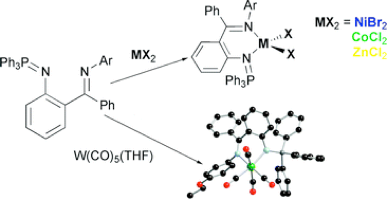
“Electron Rich Bidentate Phosphinimine-Imine Ligands: Synthesis and Reactivity of Late Transition Metal Complexes”
Invited article in special “New Talent” issue.
Electron rich phosphinimine-imine proligands Ph3PN(C6H4)C(Ph)(NAr) (LAr) (Ar = 4-(OEt)C6H4 (OEt), 3,5-Me2C6H3(Xyl)) were synthesized in three steps from 2-aminobenzophenone. These compounds, along with previously reported LMes and LTol (Mes = 2,4,6-Me3C6H2, Tol = 4-MeC6H4) were used to synthesize a series of tetracarbonyltungsten(0) complexes: LMesW(CO)4 (1), LTolW(CO)4 (2), LOEtW(CO)4 (3), and LXylW(CO)4 (4). The ligands were evaluated by analysis of the carbonyl stretching frequencies of the tungsten complexes and were shown to be better σ-donors and poorer π-acceptors compared to similar ligands in the literature. The coordination chemistry of the proligands was expanded to other late transition metals and LMesCoCl2 (5), LTolCoCl2 (6), LMesNiBr2 (7), LTolNiBr2 (8), LMesZnCl2 (9), and LTolZnCl2 (10) were synthesized by the direct reaction of LMes and LTol with the respective metal dihalide precursors. The complexes were fully characterized and the molecular structures of complexes 3, 6, 7, and 10 were reported. The synthesis of zinc complexes 9 and 10 was dependent on the steric bulk of the ligand. Complex 10 proved to be resistant to derivatization via a number of routes.